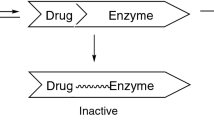Abstract
The superfamily of heme-thiolate proteins known as the cytochromes P450 is responsible for the oxidative metabolism of the majority of drugs. Thus, the phenotypes of individuals with respect to their levels of catalytically active cytochromes P450 determines to a large part the substantial interindividual variation observed in the metabolic clearance of drugs. Over the past 10 years 15 different human cytochromes P450 involved in drug metabolism have been isolated and characterized to varying degrees. This brief review discusses the characterization of these cytochromes P450 and how this knowledge has been used by the pharmaceutical industry to aid in the development of new drugs.
Similar content being viewed by others
References
D. R. Nelson, T. Kanataki, D. J. Waxman, F. P. Guengerich, R. W. Estrabrook, R. Feyereisen, F. J. Gonzalez, M. J. Coon, I. C. Gunsalus, O. Gotoh, K. Okuda, and D. W. Nebert. The P450 Superfamily: Update on new sequences, gene mapping, accession numbers, early trival names of enzymes, and nomenclature.DNA Cell Biol. 12:1–51 (1993).
S. A. Wrighton and J. C. Stevens. The human cytochromes P450 involved in drug metabolism.Crit. Rev. Toxicol. 22:1–21 (1992).
F. P. Guengerich. Human cytochromes P450. In P. R. Ortiz de Montellano (ed.),Cytochromes P450; Structure, Mechanism, and Biochemistry, Plenum Press, New York, 1995, pp. 473–535.
G. T. Tucker. Clinical implications of genetic polymorphism in drug metabolism.J. Pharm. Pharmacol. 46:417–424 (1994).
A. M. Batt, G. Siest, J. Magdalou, and M. M. Galteau. Enzyme induction by drug and toxins.Clin. Chim. Acta 209:109–121 (1992).
M. Murray. P450 Enzymes; inhibition mechanisms, genetic regulation and effects of liver disease.Clin. Pharmacokin. 23:132–146 (1992).
S. A. Wrighton, M. VandenBranden, J. C. Stevens, L. A. Shipley, B. J. Ring, A. E. Rettie, and J. R. Cashman.In vitro methods for assessing human hepatic drug metabolism: Their use in drug development.Drug Metab. Rev. 25:453–484 (1993).
S. A. Wrighton, B. J. Ring, and M. VandenBranden. The use ofin vitro metabolism techniques in the planning and interpretation of drug safety studies.Toxicol. Pathol. 23:199–208 (1995).
D. J. Birkett, P. I. Mackenzie, M. E. Veronese, and J. O. Miners.In vitro approaches can predict human drug metabolism.Trends in Pharmacol. Sci. 14:292–294 (1993).
M. V. Relling, J. S. Lin, G. D. Ayers, and W. E. Evans. Racial and gender differences inN-acetyltransferase, xanthine oxidase, and CYP1A2 activities.Clin. Pharmacol. Ther. 52:643–658 (1992).
P. Fernandez-Saluero, S. M. G. Hoffman, S. Cholerton, H. Mohrenweiser, H. Raunio, A. Rautio, O. Pelkonen, J. Huang, W. E. Evans, J. R. Idle, and F. J. Gonzalez. A genetic polymorphism in coumarin 7-hydroxylation: Sequence of the human CYP2A genes and identification of variant CYP2A6 alleles.Am. J. Hum. Genet. 57:651–660 (1995).
T. Shimada, H. Yamazaki, M. Mimura, Y. Inui, and F. P. Guengerich. Interindividual variations in human liver cytochrome P-450 enzymes involved in the oxidation of drugs, carcinogens and toxic chemicals: Studies with liver microsomes of 30 Japanese and 30 Caucasians.J. Pharmacol. Exp. Ther. 270:414–423 (1994).
A. Rahman, K. R. Korzekwa, J. Grogan, F. J. Gonzalez, and J. W. Harris. Selective biotransformation of taxol to 6-alpha-hydroxy taxol by human cytochrome P450 2C8.Cancer Res. 54:5543–5546 (1994).
S. A. Wrighton, J. C. Stevens, G. W. Becker, and M. VandenBranden. Isolation and characterization of human liver cytochrome P450 2C19: Correlation between 2C19 and (S)-mephenytoin 4′-hydroxylation.Arch. Biochem. Biophys. 306:240–245 (1993).
S. M. F. de Morais, G. R. Wilkinson, J. Blaisdell, K. Nakamura, U. A. Meyer, and J. A. Goldstein. The major genetic defect responsible for the polymorphism of (S)-mephenytoin metabolism in humans.J. Biol. Chem. 269:15419–15422 (1994).
K. Iwahashi, Y. Matsuo, H. Suwaki, K. Nakamura, and Y. Ichikawa. CYP2E1 and ALDH2 genotypes and alcohol dependence in Japanese.Alco. Clin. Exp. Res. 19:564–566 (1995).
B. J. Ring, C. J. Parli, M. C. George, and S. A. Wrighton.In vitro metabolism of zatosetron: Interspecies comparison and role of CYP3A.Drug Metab. Dispos. 22:352–357 (1994).
Author information
Authors and Affiliations
Rights and permissions
About this article
Cite this article
Wrighton, S.A., VandenBranden, M. & Ring, B.J. The human drug metabolizing cytochromes P450. Journal of Pharmacokinetics and Biopharmaceutics 24, 461–473 (1996). https://doi.org/10.1007/BF02353474
Published:
Issue Date:
DOI: https://doi.org/10.1007/BF02353474



